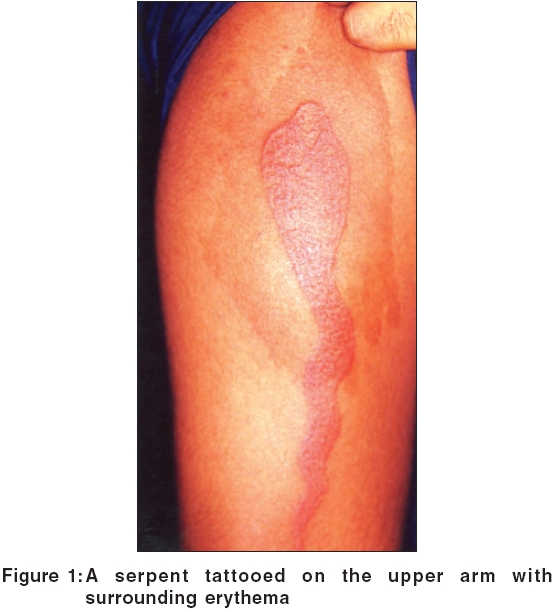Translate this page into:
Pseudo-tattoo dermatitis
Correspondence Address:
Vandana Mehta Rai
Department of Skin and STD, Kasturba Medical College, Manipal - 576 104, Karnataka
India
| How to cite this article: Rai VM, Shenoi S D. Pseudo-tattoo dermatitis. Indian J Dermatol Venereol Leprol 2006;72:232-234 |
 |
 |
 |
 |
Sir,
Skin painting (pseudo-tattooing) with henna, which is traditionally performed in Muslim and Hindu communities, is gaining widespread popularity nowadays, especially among the younger generation. We report one such case of contact dermatitis following use of black henna mixture. The reaction was associated with prior sensitization to p-phenylenediamine (PPD).
A 19-year-old medical student presented with an itchy erythematous vesicular eruption on the right upper arm of 3 days duration. He had had a temporary henna tattoo at this site 2 weeks back while on holiday in Goa. The tattoo had subsequently faded off to leave behind an erythematous eruption the shape of which corresponded exactly to the tattoo design [Figure - 1].
There was no past exposure to henna, although the patient had used hair dyes occasionally. Patch testing revealed a negative reaction to commercial henna powder and 1+ and 2+ reaction to PPD [Figure - 2] at 72 and 96 h respectively. White petrolatum was used as control.
Henna and vegetable extracts that are used to color the hair naturally are usually not responsible for allergic contact dermatitis;[1] however, fatal reactions such as angioneurotic edema of face, lips, pharynx, larynx and bronchi progressing to acute renal tubular necrosis[2] have been reported. Cronin reported immediate type of hypersensitivity reaction to henna.[3]
PPD is sometimes used to speed up the process of hair dyeing and to give henna a dark brown to black color. It can induce allergy per se or be a marker of allergy to other diaminobenezenes present in the black henna mixture. Diaminobenzenes often show cross reactivity with PPD and concomitant sensitization is possible.
Skin painting has been recently reported as a cause of skin allergy in females who use such preparations and a possible consequence would be the future occurrence of allergic contact dermatitis after new contact with PPD or its derivatives.[4] The risk of active sensitization increases further due to lack of oxidizing agent hydrogen peroxide in the mixture leading to a prolonged contact with PPD.
Our patient must have developed an allergic reaction at the tattoo site due to prior sensitization by PPD that was present in the hair dyes used by him occasionally. This was further confirmed by a positive patch test result; however, we did not perform patch testing with diaminobenzene and diaminotoluene. Patients and practitioners need to be aware of sensitization to PPD and its derivatives due to misappropriated use of hair dye preparations such as skin paint by transient artists, the long-term consequences of which include dyschromic scars and contact dermatitis after hair coloring with dyes based on PPD.
| 1. |
Pasricha JS, Gupta R, Panjwani S. Contact dermatitis to henna (Lawsonia). Contact Dermatitis 1980;6:288-9.
[Google Scholar]
|
| 2. |
Lestringant GG, Bener A, Fossard PM. Cutaneous reactions to henna and associated additives. Br J Dermatol 1999;141:598-600.
[Google Scholar]
|
| 3. |
Cronin E. Immediate - type hypersensitivity to henna. Contact Dermat 1979;5:198.
[Google Scholar]
|
| 4. |
Coz CJ, Lefebvre C, Keller F. Allergic contact dermatitis caused by skin painting (psuedotattooing) with black henna, a mixture of henna and p-phenylenediamine and its derivatives. Arch Dermatol 2000;136:1515-7.
[Google Scholar]
|
Fulltext Views
2,468
PDF downloads
2,717





